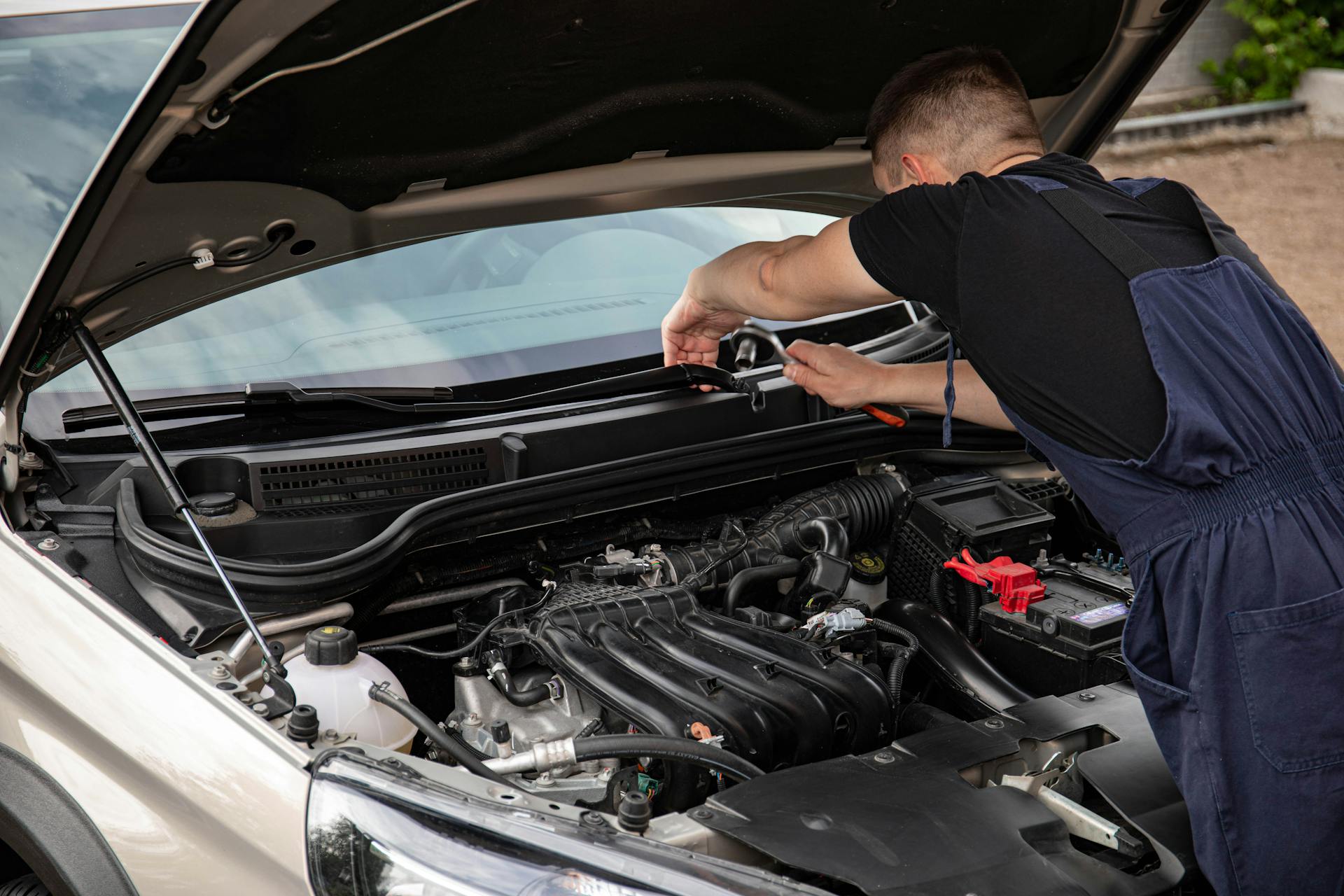
Car lease hacks can save you thousands of dollars over the life of your lease. The average lessee can save up to $3,000 by negotiating the price of their lease.
The key to getting a good deal is to do your research. Knowing the market value of your desired vehicle can give you the upper hand when negotiating with the dealer.
Understanding Leasing
Leasing a car can be a smart financial move, but it's essential to understand the basics before signing on the dotted line. Leasing allows you to drive a vehicle for an extended period without paying for or financing the purchase, instead making monthly leasing fees.
To get a good lease deal, look for subsidized leases offered by the automaker's own finance arm, such as Ford Motor Credit or Honda Finance. These deals can be cheaper because the automaker is trying to clear the decks of slow-selling cars, but be aware that they might not be for a car you actually want.
You might enjoy: Leasing a Vehicle in Texas
The cheapest deals will hover around the $100 per $10,000 mark, so calculate your monthly lease payment per $10,000 worth of vehicle to compare different lease deals. A good lease deal will have a monthly payment of less than $135 per $10,000 worth of vehicle.
To calculate your monthly lease payment, you need to know the lease interest rate, aka the money factor. A money factor of .00166 is equivalent to a 4 percent annual percentage rate. To convert a money factor to its equivalent percentage rate, multiply it by 2,400.
Here's a quick reference table to help you compare lease deals:
Remember, a low money factor is a good thing, and anything over .0075 translates to an interest rate of over 18%.
What Is Leasing?
Leasing allows you to drive a vehicle for an extended period without paying for or financing the purchase.
With a car lease, you pay a monthly leasing fee to drive the car for a few years and then return it. You can also purchase your lease, but many lessees walk away from a car lease needing to arrange another form of transportation.
Historically, car leasing has been more affordable than financing and maintaining a car, at least in the short term.
Related reading: If I Lease a Car Can I Buy It Later
Brush Up on Terms
Brush up on lease terms and you'll be a pro in no time. Knowing the rules of the game is key to staying competitive and getting the best deal possible.
A high residual value is a good thing, as it means you'll finance less over the life of your lease. Look for a residual value that's high, as this will save you money in the long run.
A low money factor is also essential. Anything below 0.00333 is a superb money factor, while over 0.0075 translates to an interest rate of over 18%. That's a huge difference, and it's worth shopping around to find a good deal.
Capitalized costs, disposition fees, and option discount adjustments are terms you should know before you set foot on a dealership lot. Don't be afraid to ask questions and clarify any terms you're unsure about.
Here are some key lease terms to know:
By knowing these terms and shopping around, you can get a great deal on your next lease. Happy negotiating!
The Basics
To understand car leasing, you need to know the basics. Leasing is simply another method of financing a vehicle, and you're doing business with a finance company, not the dealer.
The lease terms can be confusing, but they're explained in plain English. There are two types of car leases: you can choose between a closed-end lease or an open-end lease.
Here are the three criteria to determine if leasing is a smart choice for you:
- You want a new car in 4 years or less
- You drive 15,000 or fewer miles per year
- You have excellent credit
If you meet these criteria, leasing can make sense, but you need to be careful and understand the terminology. Most car shoppers don't realize that leasing a vehicle is not the same as renting. You're paying for the use of the vehicle, plus the interest payment, called the money factor.
Suggestion: Leasing Foundation
Calculating the Lease
Calculating the lease can be a daunting task, but it's a crucial step in finding a good deal. Dealers often use confusing terminology to make it seem complicated, but it's actually pretty straightforward.
You can compare different lease deals by figuring out the monthly cost per $10,000 worth of vehicle. A good lease deal will have a monthly payment of less than $135 per $10,000. The best deals will hover around $100 per $10,000.
Lease payments are made up of three parts: depreciation, interest (also known as the money factor), and taxes. It's a good idea to calculate these costs yourself to avoid being taken advantage of. Dealers love confused car buyers, so being in the know can save you money.
Here's a simple way to compare lease deals:
By understanding how lease deals are calculated, you can negotiate a better deal and avoid hidden fees.
Calculating the Lease
Calculating the lease can be a daunting task, especially with all the weird terminology thrown around. It's essential to understand how a lease is calculated so you can make an informed decision.
A good lease deal is one where the monthly lease payment is less than $135 per $10,000 worth of vehicle. If you're lucky, you might even find a deal that hovers around the $100 per $10,000 mark.
A fresh viewpoint: How to Lease a Car and Get the Best Deal
Lease payments are made up of three parts: depreciation, interest (also known as money factor), and taxes. It's actually pretty easy to calculate once you know how to do it.
To calculate the lease, you need to figure out the monthly cost per $10,000 worth of vehicle. This is a simple method that allows you to compare different lease deals quickly.
Here's a quick reference guide to help you calculate the lease:
Don't feel intimidated by the lease calculation process. It's actually pretty straightforward once you know how to do it. Dealers love confused car buyers, so it's essential to be in the know on this subject.
Price Variability
One of the most important things to keep in mind when calculating a lease is that one price does not fit all cars. This means that prices can vary significantly from one model to another, even within the same manufacturer.
The reason for this variability is that dealerships have financial goals beyond their estimated profit margins, and they're thinking about how much they'll make when you return the car at the end of the term. This can lead to prices being all over the place for certain models.
Consider reading: One Year Car Lease Agreement
If you see a car with a lease cost that's much higher than the MSRP, you may want to consider another one. This can help you avoid overpaying for a lease.
Here are some examples of lease prices for popular luxury cars:
Keep in mind that these prices are just examples, and actual prices may vary depending on the dealership and the terms of the lease.
By being aware of price variability, you can make a more informed decision when choosing a lease and avoid overpaying for a car.
Minimizing Expenses
You can save money by having an independent garage make necessary repairs before your lease expires. This can be less expensive than going through the dealer.
If you need to replace your tires, buying them yourself can be cheaper than buying from the dealer. Expect to pay for all four tires, as most leases specify that they must match.
Don't let the dealer talk you into a "loyalty" lease without shopping around. You owe it to yourself to find the best deal on your next lease.
A unique perspective: How to Buy Car after Lease
Fees and Other Costs
Leasing a car can be a great option, but it's essential to understand the fees and costs involved. You'll typically need to pay an acquisition fee, which can range from $250 to $1,000.
When you lease a car, you'll also be charged a disposition fee, usually between $200 to $400. This fee is in addition to any other costs you'll incur.
Some leases require a security deposit, which is refundable when you return the vehicle. However, you'll still need to pay fees like dealer doc fees, tag, title, registration, and license fees.
These fees can add up quickly, so it's crucial to factor them into your budget. If you decide to buy the vehicle at the end of the lease, you'll have to pay these fees again.
Leasing companies often require higher levels of insurance, which can increase your premiums. In most cases, your state's minimum insurance coverage won't be enough, so be prepared for higher costs.
Here are some estimated fees you may need to pay when leasing a car:
Minimizing Expenses
You can save money on repairs by taking your car to an independent garage, not just the dealer that leased it to you. At least a month before your lease expires, have the vehicle inspected to determine what repairs are needed.
Buying your own tires can be less expensive than buying them from the dealer, especially if you need to replace all four. Most leases require that tires match, so be prepared to pay for all four new tires.
Be aware of "loyalty" leases that dealers may try to persuade you to sign, and shop around as carefully as you did for the original lease. If you do decide to lease anew from your original dealer, make sure that any forgiven end-of-lease charges aren't "wrapped" into the next lease.
Don't forget to ask about your security deposit, which is often equivalent to one or two months' payment. If you have a good credit history, you may be able to get this fee waived.
If you need to terminate your lease early, consider using a service like LeaseTrader.com or Swapalease.com to find someone to take over your lease. Be aware that many lease companies charge a transfer fee or prohibit lease transfer.
A fresh viewpoint: Car Lease Early Termination Fee
Frequently Asked Questions
What is the 1 rule in car leasing?
The One-Percent Rule in car leasing calculates the lease payment percentage by dividing the monthly lease payment by the vehicle's Manufacturer's Suggested Retail Price (MSRP). A result close to 1% indicates a good lease offer.
Sources
- https://www.consumerreports.org/money/car-financing/how-to-get-the-best-car-lease-a5526450548/
- https://www.consumerreports.org/money/car-financing/money-saving-tips-for-leasing-a-car-a1089995228/
- https://www.realcartips.com/leasing/
- https://www.finn.com/en-DE/blog/leasing/best-way-to-lease-a-car
- https://belowinvoice.com/top-car-lease-hacks/
Featured Images: pexels.com


